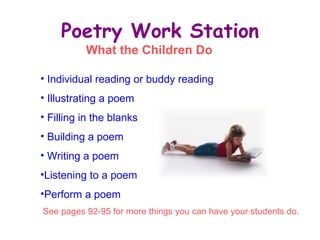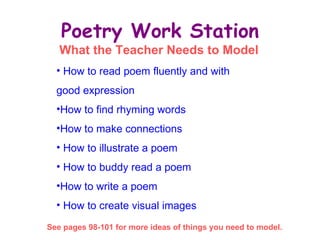Poetry workstation
- 1. Poetry Work Station Individual reading or buddy reading Illustrating a poem Filling in the blanks Building a poem Writing a poem Listening to a poem Perform a poem See pages 92-95 for more things you can have your students do. What the Children Do
- 2. Poetry Work Station How to read poem fluently and with good expression How to find rhyming words How to make connections How to illustrate a poem How to buddy read a poem How to write a poem How to create visual images What the Teacher Needs to Model See pages 98-101 for more ideas of things you need to model.
- 3. Poetry Work Station Ways to Keep the Station Going Change the poems and add new poetry books Write poem with the class and add to the station Add new paper or shape paper for copying poems Change the focus of the station to song writing, tongue twisters or jump rope rhymes Add new writing and drawing tools for illustrating poems See pages 102 and 103 for more ideas.
- 4. Poetry Work Station Periodically use the Poetry Station Assessment Form (Appendix G ĻC Pages 208 and 209) Have students share favorite poems during work station sharing time. Periodically collect poetry notebooks or poems students write Assessing and Keeping Kids Accountable



